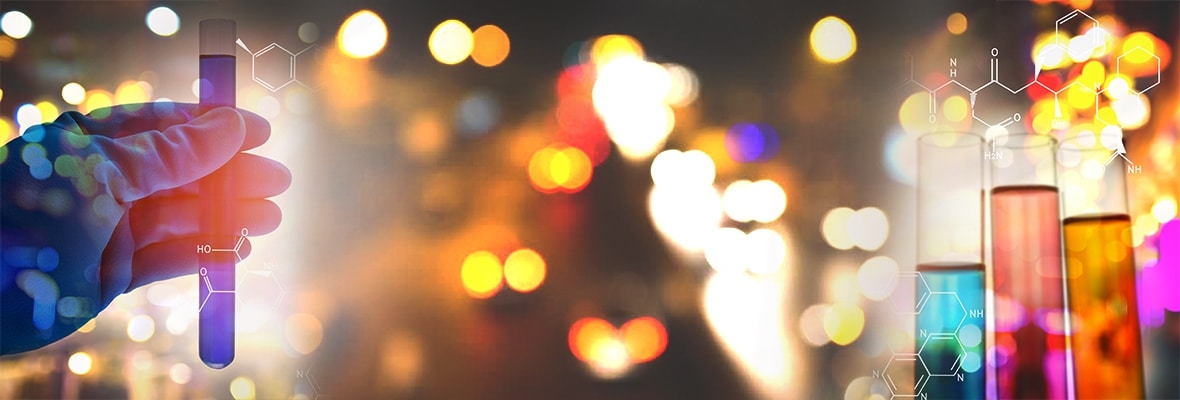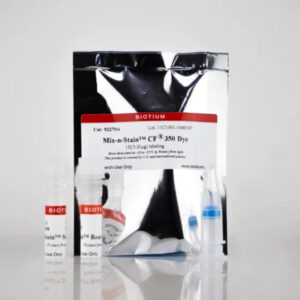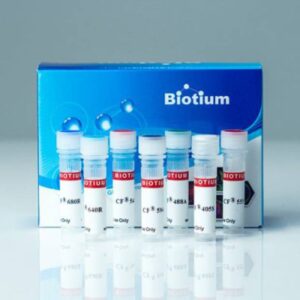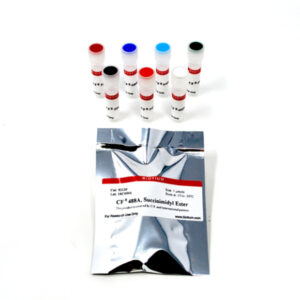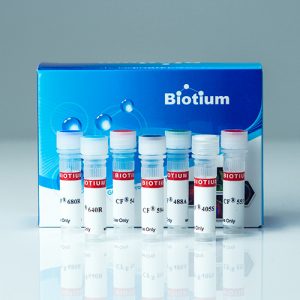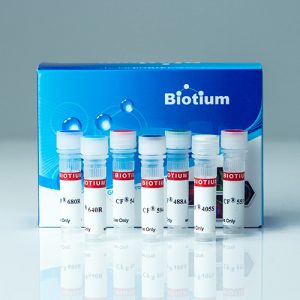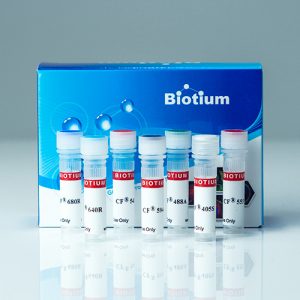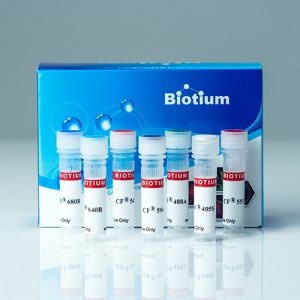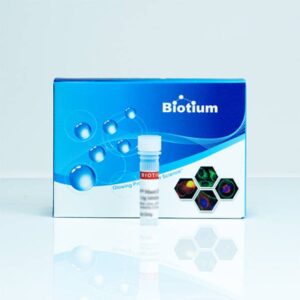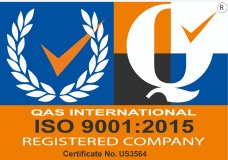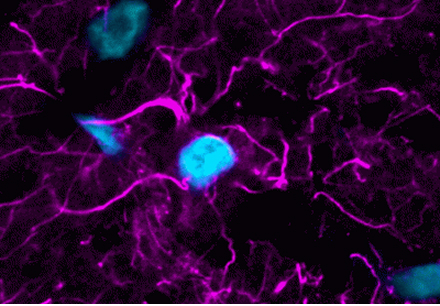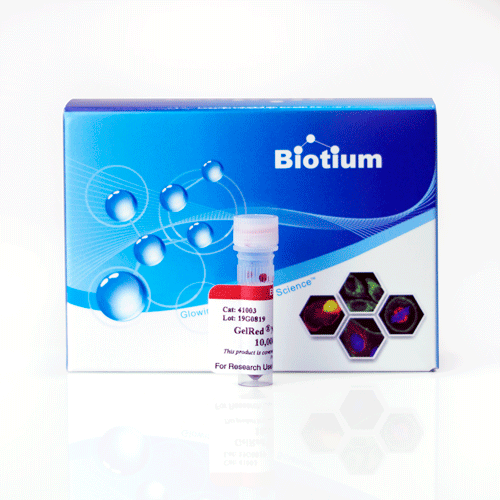Amine-Reactive Succinimidyl Esters
Our amine-reactive CF® Dyes provide superior labeling efficiency due to their industry-leading purity and a more stable form of SE.
Succinimidyl esters (SE, also known as NHS esters) react with primary amines, such as lysine residues in proteins. Succinimidyl ester labeling is commonly used for conjugation of proteins and antibodies. The reaction requires a basic pH for amine groups on the target protein to be deprotonated and react with SE, and is usually performed in pH 8.3 bicarbonate buffer. Succinimidyl ester dyes have the disadvantage of hydrolyzing over time in the presence of water. Heavily sulfonated dyes, such as the Alexa Fluor® dyes, DyLight® dyes, and IRDye®, are particularly hygroscopic, worsening the hydrolysis problem.
Due to Biotium’s unique manufacturing and packaging process, our amine-reactive CF® Dyes are provided with the highest purity and more stable SE dye forms than other vendors. As a result, our CF® Dye SE products retain more reactivity and provide a higher labeling efficiency for users.
We offer more than 40 CF® Dyes in SE form, and supply anhydrous DMSO that can be used to prepare SE stock solutions that are stable at -20°C for up to one month.
Advantages of CF® Dye Succinimidyl Esters
- High labeling efficiency due to industry-leading purity and more stable SE dye forms
- Offered with Biotium’s bright and photostable CF® Dyes which provide superior signal-to-noise
- Available in over 40 CF® Dye colors from blue to near-IR wavelengths
Our CF® Dye and Biotin SE Protein Labeling Kits include all components for labeling and purifying 3 x 1 mg protein reactions. For fast and simple antibody labeling, see our Mix-n-Stain™ Labeling Kits. VivoBrite™ Rapid Antibody Labeling Kits for Small Animal Imaging include all components for conjugation of our superior near-infrared CF® Dyes for small animal imaging.
Cyanine NS succinimidyl esters are non-sulfonated cyanine dyes that can be used to label proteins, oligonucleotides and nucleic acids. Cyanine 488NS, Cyanine 555NS, and Cyanine 647NS are non-sulfonated versions of Cyanine 488, Cyanine 555, and Cyanine 647, respectively, that have matching charge and molecular weight for 2D DIGE platform. We also offer a wide selection of classic amine-reactive dye and biotinylation reagents.
CF® Dye Succinimidyl Esters & Labeling Kits
| Product | Features |
|---|---|
| CF® Dye SE/TFP Esters | • Amine-reactive chemistry widely used for protein and antibody labeling • Over 40 bright & photostable CF® Dye colors • More stable SE for excellent labeling efficiency |
| CF® Dye & Biotin SE Protein Labeling Kits | • Everything you need for labeling and purification of 3 x 1 mg protein reactions • Wide selection of CF® Dye colors plus biotin |
| VivoBrite™ Rapid Antibody Labeling Kits for Small Animal In Vivo Imaging | • Everything you need for labeling and purification of 3 x 1 mg protein reactions for in vivo imaging • Featuring our superior near-IR CF® Dyes |
| Mix-n-Stain™ Labeling Kits | • Simply and rapidly label small amounts of antibody with no purification required • Label antibodies with CF® Dyes, fluorescent proteins, tags, or enzymes • Small ligand labeling kits available |
| Cyanine Dye SE | • Cyanine 555, Cyanine 647, Cyanine 680, & Cyanine 750 |
| Cyanine NS SE | • Non-sulfonated dyes with matching charge & MW for 2D DIGE • Cyanine 488NS, Cyanine 555NS, and Cyanine 647NS |
| Classic Amine-Reactive Dyes & Biotin | • Wide selection of classic amine-reactive dyes and biotinylation reagents |
| Anhydrous DMSO | • Essential for preparation of SE stock solutions |
| Ultrafiltration Vials | • For easy spin-column removal of free dye after labeling proteins • 3K MWCO or 10K MWCO |
Thiol-Reactive Maleimide & MTS Dyes
Methanethiosulfonate (MTS) is a fast-reacting and highly selective thiol-reactive functional group. We offer MTS with a selection of popular CF® Dyes, biotin, classic dyes, and as thiol-modifying and cross-linking reagents.
We also offer many classic thiol-reactive dyes and biotin, as well as reducing agents commonly used in thiol conjugation protocols.
Thiol-Reactive CF® Dyes & Related Reagents
| Product | Features |
|---|---|
| CF® Dye Maleimides | • Commonly used thiol-reactive chemistry • ~30 bright & photostable CF® Dye colors |
| CF® Dye MTS | • Fast-reacting dyes with excellent thiol selectivity • Available with a selection of popular CF® Dyes |
| Other Thiol-Reactive Dyes & Compounds | • Wide selection of classic dyes & biotin |
| MTS Thiol-Modification Reagents | • Thiol-reactive methanethiosulfonate compounds and cross-linkers • Useful for analysis of disulfide bonds in proteins |
| Reducing Agents | • DTT & TCEP reducing agents frequently used for generating free thiols for labeling |
Dyes for Labeling Carbonyl Groups & Carbohydrates
Hydrazides also react with aldehydes or ketones, but form unstable hydrazone linkages. Hydrazides are non-toxic and highly water soluble, making them useful as fluid phase markers and fixable microinjectable cytoplasmic tracers.
We offer dyes and biotin with aminooxy or hydrazide functional groups, and CF®DI reactive dyes, which have matched molecular weight and charge for 2D DIGE platform.
Aminooxy & Hydrazide Reagents
| Product | Features |
|---|---|
| CF® Dye Aminooxy | • Reacts with aldehydes & ketones to form stable linkage • Wide selection of bright & photostable CF® dye colors |
| CF®DI Aminooxy | • CF®DI aminooxy dyes have matching charge & MW for 2D DIGE • Green fluorescent CF®DI 488, red fluorescent CF®DI 555, and far-red fluorescent CF®DI 647 |
| Cyanine Dye Aminoxy | • Red fluorescent Cyanine 555 and far-red fluorescent Cyanine 647 |
| CF® Dye Hydrazide | • Reacts with aldehydes & ketones • Useful polar tracers • Wide selection of bright, photostable, and highly soluble CF® dye colors |
| CF®DI Hydrazide | • CF®DI hydrazide dyes have matching molecular weight and charge • Green fluorescent CF®DI 488, red fluorescent CF®DI 555, and far-red fluorescent CF®DI 647 |
| Other Aminooxy & Hydrazide Reagents | • Selection of classic dyes and biotin |
| Aniline, 10X in Acetate Buffer | • Catalyst for aminooxy & hydrazide reactions |
Dyes with a Free Amine Group
CF® Dye Amines can be used to conjugate CF® Dyes, other dyes, or biotin to carboxylic acids groups in biological molecules. After activation with water soluble carbodiimides, carboxylic acids react with amine-functionalized dyes to form stable amide bonds, enabling efficient and lasting conjugations.
Amine-containing dyes or biotin compounds, like Lucifer Yellow Cadaverine or Neurobiotin™, are also widely used as fluid phase markers for neuronal tracing, as well as gap junction connectivity and dye permeability studies.
Dyes with an Amine Group
| Product | Features |
|---|---|
| CF® Dye Amine | • Conjugate CF® Dyes to carboxylic acids groups in biological molecules • Selection of popular CF® dye colors |
| Other Dye and Biotin Amines | • Selection of classic and biotin amines • Polar tracers for neuronal injection or gap junction studies |
| EDC (EDAC) | • Water soluble carbodiimide • Activates carboxylic acids for reaction with amines |
Azides, Alkynes, & BCN for Bioorthogonal Chemistry
Reagents for Bioorthogonal Labeling
| Product | Features |
|---|---|
| Azides | • Copper-catalyzed reaction with alkyne • Copper-free reaction with BCN • Staudinger ligation with phosphine • Wide selection of CF® Dye colors & biotin |
| Picolyl Azides | • Reacts with alkyne at low copper concentrations • Selection of popular CF® Dye colors & biotin |
| Alkynes | • Copper-catalyzed reaction with azide • Polymer formation • Wide selection of CF® Dye colors or biotin • Cyanine 555 and Cyanine 647 for 2D DIGE |
| DBCO Reagents | • Copper-free reaction with azide • Fast-reacting alternative to BCN or DIBO • Wide selection of CF® Dyes |
| BCN Reagents | • Copper-free reaction with azide • Wide selection of CF® Dyes or biotin • Membrane permeant dye-BCN options • MTS-BCN allows conjugation of thiol groups to BCN |
| Tetrazine & TCO | • Tetrazines react with TCO via copper-free reaction • Wide selection of CF® Dyes or biotin |
ViaTag™ Haloalkane Ligands
HaloTag® is a 34 kDa protein tag that forms a rapid, covalent bond with fluorescent haloalkane ligands, enabling stable and specific labeling of fusion proteins for fluorescence-based detection. Biotium’s ViaTag™ Haloalkane Ligands leverage this system to deliver bright, reliable fluorescence with minimal background in live or fixed cells. Offered in cell-permeant and cell-impermeant formats with color options from blue to near-infrared, ViaTag™ ligands enable flexible labeling of intracellular or cell-surface HaloTag® fusion proteins, with covalent attachment that withstands fixation, permeabilization, and protein extraction.
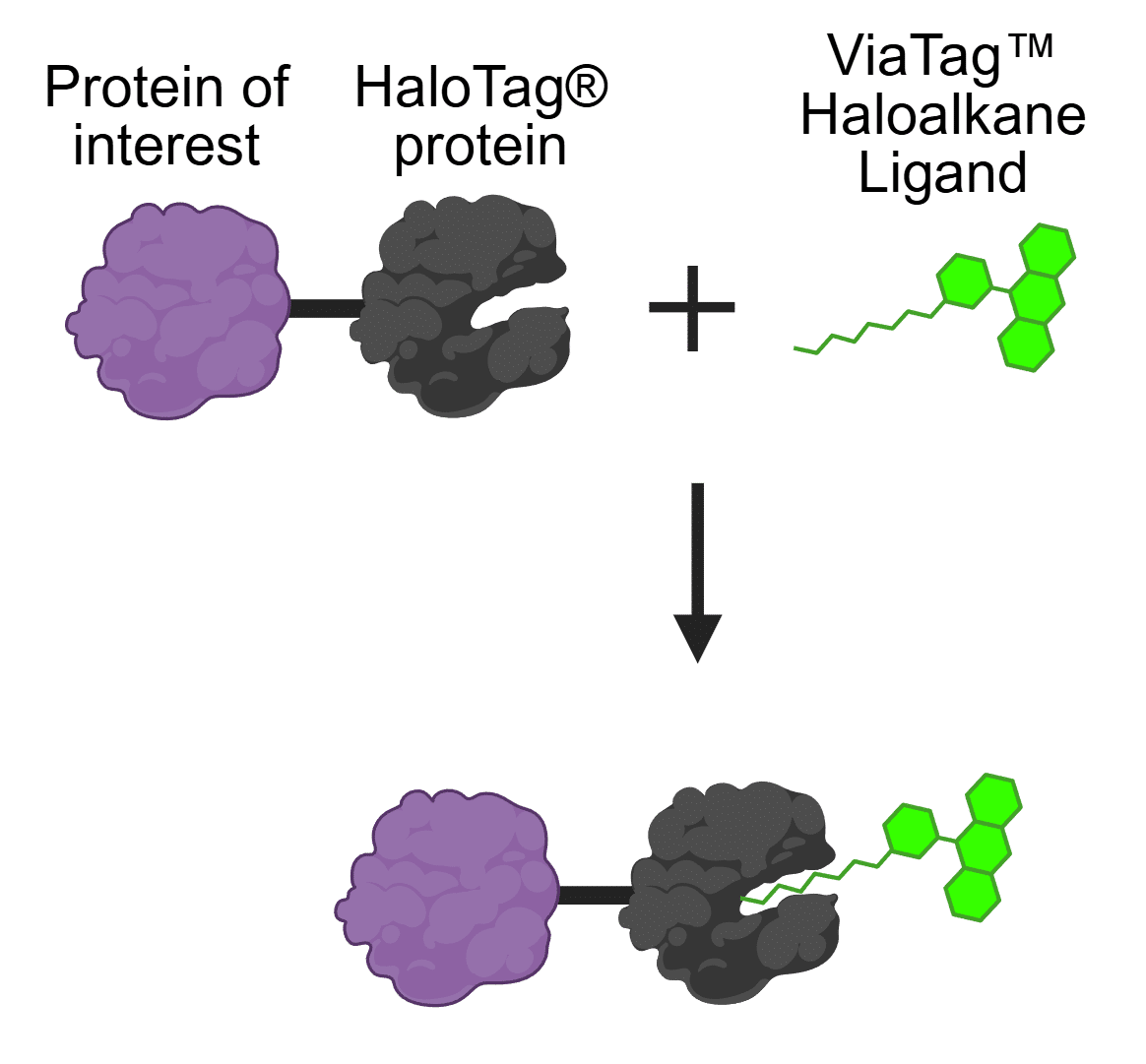
Advantages of ViaTag™ Haloalkane Ligands
- Rapid covalent labeling of HaloTag® protein tags
- Stable and ready-to-use DMSO stock solutions
- Minimal wash steps required
- Cell permeant and impermeant ligands, label live or fixed cells
- Wide selection of fluorescent colors from UV to near-IR
- Cost-effective alternative to other haloalkane ligands
Choose from 11 bright colors, with flexible options for intracellular or cell surface targets
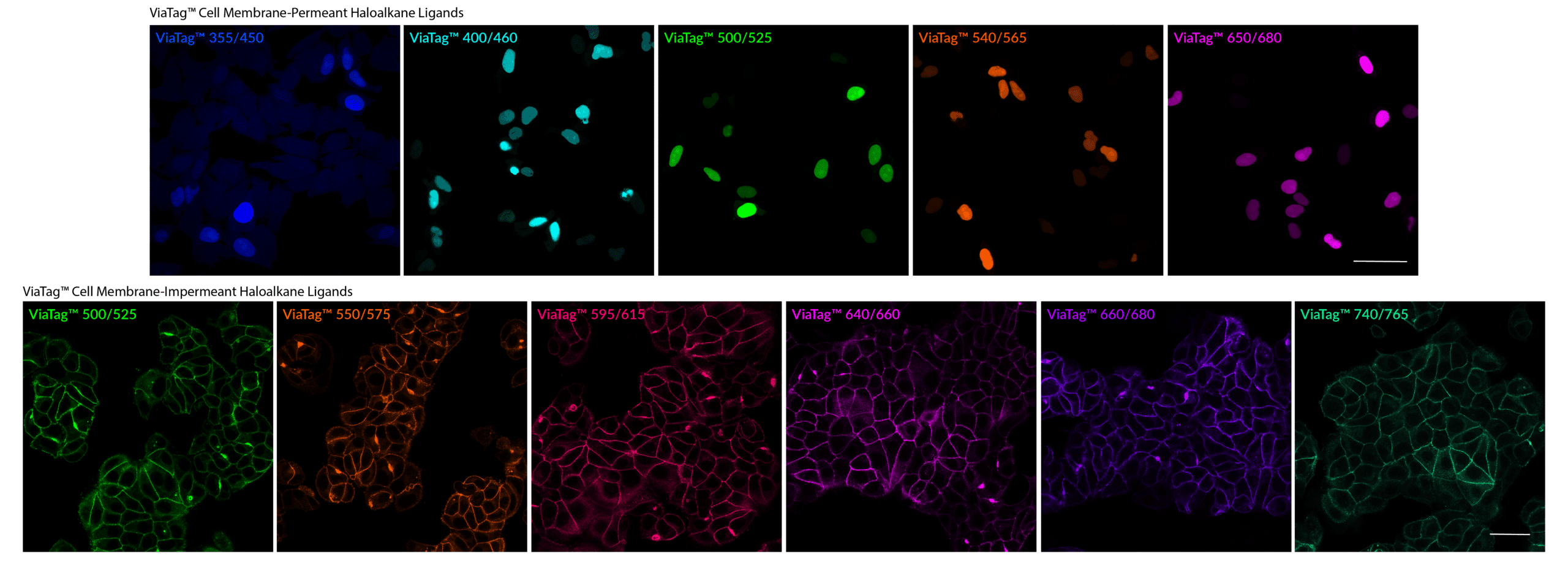
ViaTag™ Haloalkane Ligands
| Dye | Catalog No. | Ex/Em | Size | Cell membrane permeability | Laser line | Channel for detection |
|---|---|---|---|---|---|---|
| ViaTag™ 355/450 Haloalkane Ligand, 1000X in DMSO | 10301 | 349/440 nm | 30 uL | Permeant | 355 nm (UV) | DAPI |
| ViaTag™ 400/460 Haloalkane Ligand, 1000X in DMSO | 10302 | 391/452 nm | 30 uL | Permeant | 405 nm | DAPI, Alexa Fluor® 405, Pacific Blue® |
| ViaTag™ 500/525 Haloalkane Ligand, 1000X in DMSO | 10303 | 504/527 nm | 30 uL | Permeant | 488 nm | FITC |
| ViaTag™ 540/565 Haloalkane Ligand, 1000X in DMSO | 10304 | 543/572 nm | 30 uL | Permeant | 555 nm, 561 nm | Rhodamine, dsRed, PE |
| ViaTag™ 650/680 Haloalkane Ligand, 1000X in DMSO | 10305 | 653/674 nm | 30 uL | Permeant | 640 nm | Alexa Fluor® 647, APC |
| ViaTag™ 490/525 Haloalkane Ligand, 1000X in DMSO | 10306 | 493/517 nm | 30 uL | Impermeant | 488 nm | FITC |
| ViaTag™ 550/575 Haloalkane Ligand, 1000X in DMSO | 10307 | 551/577 nm | 30 uL | Impermeant | 555 nm, 561 nm | Rhodamine, dsRed, PE |
| ViaTag™ 595/615 Haloalkane Ligand, 1000X in DMSO | 10308 | 593/615 nm | 30 uL | Impermeant | 561 nm, 594 nm | Texas Red® |
| ViaTag™ 640/660 Haloalkane Ligand, 1000X in DMSO | 10309 | 642/663 nm | 30 uL | Impermeant | 640 nm | Alexa Fluor® 647, APC |
| ViaTag™ 660/680 Haloalkane Ligand, 1000X in DMSO | 10310 | 662/682 nm | 30 uL | Impermeant | 640 nm | Alexa Fluor® 660 |
| ViaTag™ 740/765 Haloalkane Ligand, 1000X in DMSO | 10311 | 742/767 nm | 30 uL | Impermeant | 730 nm | Alexa Fluor® 750 |
PACIFIC BLUE, TEXAS RED, and ALEXA FLUOR are registered trademarks of Thermo Fisher Scientific; CY DYE is a registered trademark of Cytiva; HALOTAG is a registered trademark of Promega Corporation.
Dye Tyramides & TSA Kits
TyraMax™ Dyes are Biotium’s next generation of tyramide amplification dyes for spatial biology. The dyes have been designed to yield a brighter signal compared to our original CF® Dye tyramides, and have advantages in brightness, photostability, and working solution stability compared to other TSA dyes. Tyramide Amplification Kits are also available with CF® Dyes or biotin with anti-mouse, anti-rabbit, or HRP streptavidin conjugates. The kits offer high sensitivity and signal-to-background ratio to visualize low-abundance targets that cannot be efficiently labeled using traditional immunostaining methods. CF® Dye, biotin, and other tyramides are also available separately.
Tyramides and Tyramide Amplification Kits
| Tyramide | Features |
|---|---|
| TyraMax™ Amplification Dyes and Kits | • Largest selection of tyramide colors available, with unique options from blue to near-IR • Stable in amplification buffer for at least 24 hours • Advantages in brightness and/or photostability compared to other TSA dyes • Available as standalone dyes with trial sizes, and dye sets for multiplexing or panel development |
| Tyramide Signal Amplification Kits | • Choice of 6 bright & photostable CF® Dyes or biotin • Choice of goat anti-mouse, goat anti-rabbit, or streptavidin HRP conjugates |
| CF® Dye Tyramides | • Choice of over 22 bright & photostable CF® Dyes |
| Other Tyramides | • Other dyes, biotin, and DNP |
Free Acid Dyes
CF® Dyes are highly water-soluble fluorescent dyes spanning the visible and near-infrared spectrum, offering superior brightness, photostability, and signal-to-noise. CF® Dye free acids are non-reactive dyes that are used as reference standards or as controls in experiments that involve CF® Dye conjugates, such as antibodies or other proteins, for cell-based or in vivo assays. We offer free acids for 12 CF® Dyes, including 4 near-infrared options. We also offer a selection of free acid forms of other classic dyes.
View Product Page
Biotinylation Reagents & Other Biotin Compounds
Biotium offers biotinylation reagents featuring a full selection of reactive functional groups, such as succinimidyl ester, aminooxy, amine, azide, alkyne, maleimide, and more. These options provide flexibility for labeling proteins, antibodies, or other biomolecules. Many of our reactive biotin reagents are also offered with longer linkers to facilitate interactions between biotin and avidin or streptavidin.
We also offer convenient and easy-to-use kits for protein and antibody biotinylation kits. Each kit comes with everything you need to perform labeling and purification.
Reactive Biotinylation Reagents
| Product | Applications |
|---|---|
| Biotin SE Protein Labeling Kit | • Everything you need to label & purify 3 x 1 mg reactions |
| Mix-n-Stain™ Biotin Antibody Labeling Kits | • Label your antibody in 15 minutes with no purification step • Choose kits to label 5-20 ug, 20-50 ug, or 50-100 ug antibody |
| Biotin Succinimidyl Ester (SE) | • Amine-reactive biotin, label proteins on lysine residues |
| Biotin-X-SE | • Amine-reactive biotin with longer linker |
| Biotin-XX-SE | • Amine-reactive biotin with longer linker |
| Biotin-12-SE | • Amine-reactive biotin with longer linker |
| Biotin-PEO4-propionate SE | • Amine-reactive biotin with a long PEG spacer |
| Biotin-X-Free Acid | • Can be converted to the mixed anhydride form, which is more amine-reactive than the SE form |
| Biotin-PEO4-Maleimide | • Thiol-reactive biotin |
| Biotin-X-C5-Maleimide | • Thiol-reactive biotin with a longer linker |
| Biotin MTSEA | • Selective labeling of cell surface thiols under mild conditions • Available with biotin, biotin-X, and biotin-XX linker lengths |
| Aminooxy Biotin | • For stable labeling of carbonyls or carbohydrates |
| Biocytin Hydrazide | • Fixable cytoplasmic tracer • Also can be used to label carbonyls or carbohydrates |
| Biotin-PEO4-Hydrazide | • Water soluble biotin for coupling to aldehydes or ketones |
| Biotin Alkyne | • Bioorthogonal conjugation to azide or picolyl azide • Polymer formation |
| Biotin Azide | • Bioorthogonal conjugation to alkyne or phosphine |
| Biotin BCN | • Copper-free bioorthogonal conjugation to azide |
| Biotin Picolyl Azide | • Biorthogonal conjugation to alkyne at low copper concentrations |
| Biotin-PEO2-PPO2-Amine, TFA salt | • Water soluble biotin derivative with a free amine for coupling to activated carboxylic acids |
| Biotin-PEO3-Amine | • Water soluble biotin for coupling to activated carboxylic acids |
| Biotin-PEO4-Amine | • Water soluble biotin for coupling to activated carboxylic acids |
| Biotin Cadaverine Free Base | • Direct coupling to activated carboxylic acid groups without using an additional base |
| Biotin-X-Cadaverine, Free Base | • Biotin-Cadaverine Free Base with longer linker |
| Biotin Cadaverine, Trifluoroacetate Salt | • Coupling to carboxylic acids, DNA, and other biomolecules in the presence of base |
| Biotin-X-Cadaverine, TFA Salt | • Biotin-Cadaverine TFA salt with longer linker |
| Biotin D(+) | • Free biotin |
| Biotin-XX-Free Acid | • Free acid biotin with a longer linker |
CY DYE is a registered trademark of Cytiva.
